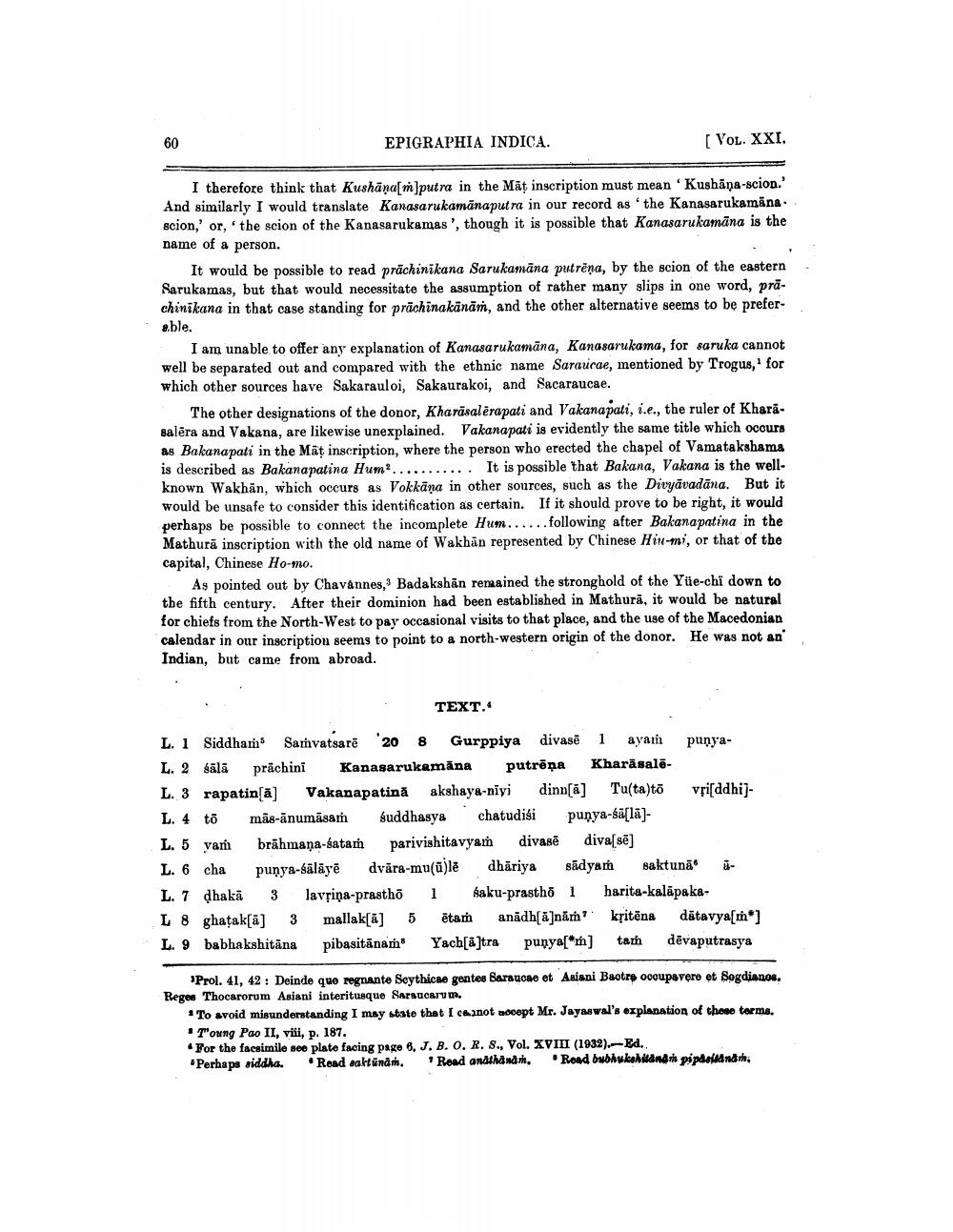________________
60
EPIGRAPHIA INDICA.
[Vol. XXI.
I therefore think that Kushāna[m putra in the Māț inscription must mean 'Kushāņa-scion.' And similarly I would translate Kanasarukamānaputra in our record as 'the Kanasarukamāna. scion,' or, the scion of the Kanasarukamas', though it is possible that Kanasarukamāna is the name of a person.
It would be possible to read prächinikana Sarukamāna putrēna, by the scion of the eastern Sarukamas, but that would necessitate the assumption of rather many slips in one word, prāchinikana in that case standing for prāchinakānām, and the other alternative seems to be preferable.
I am unable to offer any explanation of Kanasaru kamāna, Kanasarukama, for saruka cannot well be separated out and compared with the ethnic name Saraucae, mentioned by Trogus," for which other sources have Sakarauloi, Sakaurakoi, and Sacaraucae.
The other designations of the donor, Kharāsalērapati and Vakanapati, i.e., the ruler of KharaBalēra and Vakana, are likewise unexplained. Vakanapati is evidently the same title which occurs as Bakanapati in the Māt inscription, where the person who erected the chapel of Vamatakshama is described as Bakanapatina Hum?........... It is possible that Bakana, Vakana is the wellknown Wakhān, which occurs as Vokkāna in other sources, such as the Divyāvadāna. But it would be unsafe to consider this identification as certain. If it should prove to be right, it would perhaps be possible to connect the incomplete Hum...... following after Bakana patina in the Mathura inscription with the old name of Wakhān represented by Chinese Hin-mi, or that of the capital, Chinese Ho-mo.
As pointed out by Chavannes, Badakshān remained the stronghold of the Yüe-chi down to the fifth century. After their dominion had been established in Mathurā, it would be natural for chiefs from the North-West to pay occasional visits to that place, and the use of the Macedonian calendar in our inscription seems to point to a north-western origin of the donor. He was not an Indian, but came from abroad.
TEXT..
L. 1 Siddhan Sarnvatsarë '20 8 Gurppiya divasë 1 aya punyaL. 2 sālā prächini Kanasarukamāna putröna KharāsaleL. 3 rapatin[ā] Vakanapatină akshaya-niyi dinn[a] Tu(ta)to vri[ddhi)L. 4 to mās-ānumāsaṁ suddhasya chatudisi punya-sä[lā)L. 5 yam brāhmaṇa-sataṁ parivishitavyam divasē divas sē] L. 6 cha punya-sälāyē dvära-mu(ū)lē dhāriya sūdya saktunā. - L. 7 dhakā 3 lavșiņa-prastho 1 saku-prastho 1 harita-kalāpakaL 8 ghatak[a] 3 mallak[a] 5 ētam anādh[@]nām' kritēna dātavya[mo] L. 9 babhakshitāna pibasitānaṁ Yach[a]tra punya[*] tam dēvaputrasya
Prol. 41, 42: Deinde quo regnante Seythicae gentes Baraucae et Asiani Baotre cooupavere et Sogdianos, Reges Thocarorum Asiani interitusque Saraucarvm.
* To avoid misunderstanding I may state that I canot noept Mr. Jayaswal's explanation of these tarma, * Toung Pao II, viii, p. 187. For the facsimile se plate facing page 8, J. B. O. R. S., Vol. XVIII (1932).-Ed. Perhaps siddha. Read altünd. Read and thand. Rond bubhukahilindrh pipdoland,




